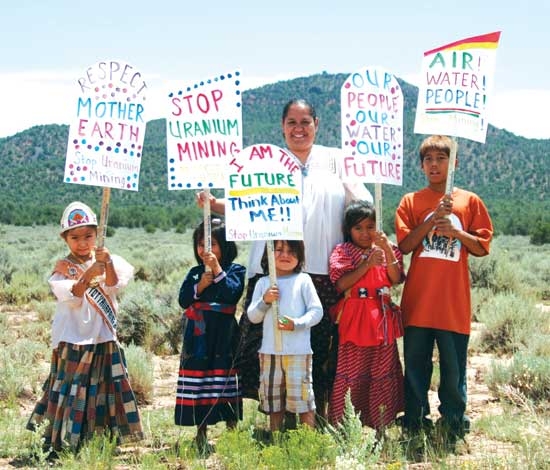 Groundswell Educational Films, NFP
Groundswell Educational Films, NFP
100 N. LaSalle St, Suite 300
Chicago, IL 60602
WASHINGTON, D.C. — As Japan struggles to contain radioactive contamination, Groundswell is reminding Americans that over a thousand abandoned Cold War-era uranium mines still contaminate the American Southwest. The US Department of Energy will feature The Return of Navajo Boy project as a case study in film, media, public engagement and measurable impacts at its State of Environmental Justice Conference on April 28th and 29th in Washington, DC. This month, the US Environmental Protection Agency began clean up at Skyline Mine, the site featured in the documentary.
Since 2000, when the film’s cautionary tale stunned Sundance Film Festival audiences, Groundswell Educational Films has brought it and Navajo activists across the country to advocate for a clean up of radioactive waste in the Navajo Nation. The filmmaker, Jeff Spitz, and Navajo participants triggered a federal investigation into uranium houses. Many Navajos, including the grandmother in the film, Elsie Mae Begay, built their homes with uranium rocks from the abandoned mines. The US government failed to warn Navajos about the dangers of radioactive waste.
Decades after ceasing operations, the radiation from more than 1,000 abandoned uranium mines continues to impact homes, livestock, land, and water across the 27,000 square mile reservation. The Navajo Nation is home to approximately 200,000 people. It holds the largest uranium deposits in the United States and suffers from the highest cancer rates in the Southwest region.
Partially as a response to the Groundswell advocacy campaign, the US Environmental Protection Agency has now begun to clean up the area around the abandoned Skyline Mine, including Elsie Mae Begay’s yard spotlighted in the documentary. This month tractors and heavy equipment rolled into Elsie’s yard eleven years after the film’s debut.
“Americans have been rightfully horrified by the unfolding nuclear disaster in Japan. But we forget that there is highly dangerous radioactive waste poisoning communities right here in America,” said Groundswell co-founder Jeff Spitz, who directed the film. “This clean up of the Skyline Mine and Elsie Begay’s yard offers a ray of hope to other families living in remote areas hoping for the same attention. We show how to get it.”
Groundswell’s unique model of film and public awareness campaign empowers Navajos to get attention by equipping them with Flip video cameras, multi-media tools, and opportunities to speak at film events, conferences, on campuses, and in the media nationwide. Navajos upload footage and Groundswell edits short videos that allow thousands of followers to stay engaged in the story unfolding online at navajoboy.com/webisodes.
“Using our own video cameras to document what we are struggling with every day gives us hope that the world has not forgotten about us. It gives us a voice,” said Mary Helen Begay, Elsie’s daughter in law and creator of two recent webisodes. “Our hearts go out to the people of Japan. We hope that they won’t have to live with radioactive waste as we have for more than 50 years now.”
About Groundswell: Groundswell Educational Films is a nonprofit organization with a mission to collaborate cross-culturally in all facets of documentary filmmaking, transfer media skills into disadvantaged communities, and partner with stakeholders to leverage changes that address the social justice issues raised in our films.

Funny how the concentration is generally on the safe use of nuclear facilities and removal of waste materials, but so rarely on the aspects of uranium mining. Radiation doesn’t confine itself. It affects everyone. The more we add to the atmosphere with uranium mining, nuclear weapons fire, nuclear waste dumps and reactor melt-downs, the more radiation we have lingering in the air to breathe, to settle in our bodies and monkey around with our cellular structures. Living a comfortable life today is not worth killing off our children.
Most people are completely unaware of the fact that most of our uranium reserves are on Native lands – this wasn’t a problem during WWII, when the U.S. government just ‘went and took’; it’s only marginally a problem now.
Ironically, even if we mined all the uranium we could find in the U.S., that supply wouldn’t provide twenty years’ worth of electricity.
Not worth the damage. Not at all….
We have a tendancy to forget people when making our waste plans and while uranium is decidedly amoungst the worst waste around we really don’t take the disposal of anything seriously.
When ever this subject comes up people postulate dump areas in desolate places like the high country in California, The plains of Texas, the entire State of Nevada. Hell, I hate Nevada myself, it has very little to recommend it. But what we forget is we also sent the Native Peoples to these same desolate areas back in the day when we were treating them as throwaways too. People are in these places that our bright minds think will have lesser impact on human life and for the life of me I cannot understand why dolphins, elephants and coral reefs get more attention than we give other people and ultimately when we understand how this planet works, ourselves.